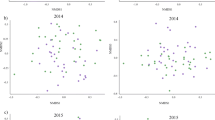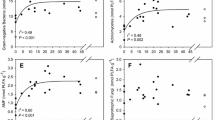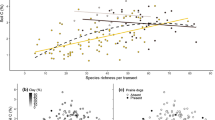Abstract
The USDA’s Conservation Reserve Program (CRP) has predominantly used only a few species of dominant prairie grasses (CP2 practice) to reduce soil erosion, but recently has offered a higher diversity planting practice (CP25) to increase grassland habitat quality. We quantified plant community composition in CP25 and CP2 plantings restored for 4 or 8 years and compared belowground properties and processes among restorations and continuously cultivated soils in southeastern Nebraska, USA. Relative to cultivated soils, restoration increased soil microbial biomass (P = 0.033), specifically fungi (P < 0.001), and restored soils exhibited higher rates of carbon (C) mineralization (P = 0.010). High and low diversity plantings had equally diverse plant communities; however, CP25 plantings had greater frequency of cool-season (C3) grasses (P = 0.007). Older (8 year) high diversity restorations contained lower microbial biomass (P = 0.026), arbuscular mycorrhizal fungi (AMF) biomass (P = 0.003), and C mineralization rates (P = 0.028) relative to 8 year low diversity restorations; older plantings had greater root biomass than 4 year plantings in all restorations (P = 0.001). Low diversity 8 year plantings contained wider root C:N ratios, and higher soil microbial biomass, microbial community richness, AMF biomass, and C mineralization rate relative to 4 year restorations (P < 0.050). Net N mineralization and nitrification rates were lower in 8 year than 4 year high diversity plantings (P = 0.005). We attributed changes in soil C and N pools and fluxes to increased AMF associated with C4 grasses in low diversity plantings. Thus, reduced recovery of AMF in high diversity plantings restricted restoration of belowground microbial diversity and microbially-mediated soil processes over time.





Similar content being viewed by others
References
Allen EB, Allen MF (1984) Competition between plants of different successional stages: mycorrhizae as regulators. Canadian Journal of Botany 62:2625–2629
Allison VJ, Miller MR, Jastrow JD, Matamala R, Zak DR (2005) Changes in soil microbial community structure in a tallgrass prairie chronosequence. Soil Science Society of America Journal 69:1412–1421
Allison VJ, Yermakov Z, Miller RM, Jastrow JD, Matamala R (2007) Using landscape and depth gradients to decouple the impact of correlated environmental variables on soil microbial community composition. Soil Biology & Biochemistry 39:505–516
Angers DA, Caron J (1998) Plant-induced changes in soil structure: processes and feedbacks. Biogeochemistry 42:55–72
Bach EM, Baer SG, Meyer CK, Six J (2010) Soil texture affects soil microbial and structural recovery during grassland restoration. Soil Biology & Biochemistry 42:2182–2191
Baer SG, Blair JM (2008) Grassland establishment under varying resource availability: a test of positive and negative feedback. Ecology 89:1859–1871
Baer SG, Rice CW, Blair JM (2000) Assessment of soil quality in fields with short and long term enrollment in the CRP. Journal of Soil and Water Conservation 55:142–146
Baer SG, Kitchen DJ, Blair JM, Rice CW (2002) Changes in ecosystem structure and function along a chronosequence of restored grasslands. Ecological Applications 12:1688–1701
Baer SG, Blair JM, Collins SL, Knapp AK (2004) Plant community responses to resource availability and heterogeneity during restoration. Oecologia 139:617–629
Baer SG, Meyer CK, Bach EM, Klopf RP, Six J (2010) Contrasting ecosystem recovery on two soil textures: implications for carbon mitigation and grassland conservation. Ecosphere 1:art5. doi:10.1890/ES10-00004.1
Beare MH, Coleman DC, Crossley DA, Hendrix PF, Odum EP (1995) A hierarchical approach to evaluating the significance of soil biodiversity to biogeochemical cycling. Plant and Soil 170:5–22
Bligh EG, Dyer WJ (1959) A rapid method of total lipid extraction and purification. Canadian Journal of Biochemistry and Physiology 37:911–917
Bossio DA, Scow KM, Gunapala N, Graham KJ (1998) Determinants of soil microbial communities: effects of agricultural management, season, and soil type on phospholipid fatty acid profiles. Microbial Ecology 36:1–12
Camill P, McKone MJ, Sturges ST, Severud WJ, Ellis E, Limmer J, Martin CB, Navratil RT, Purdie AJ, Sandel BS, Talukder S, Trout A (2004) Community- and ecosystem-level changes in species-rich tallgrass prairie restoration. Ecological Applications 14:1680–1694
Craine JM, Wedin DA, Chapin FS, Reich PB (2003) The dependence of root system properties on root system biomass of 10 North American grassland species. Plant and Soil 250:39–47
DeGrood SH, Claassen VP, Scow KM (2005) Microbial community composition on native and drastically disturbed serpentine soils. Soil Biology and Biochemistry 37:1427–1435
Delisle JM, Savidge JA (1997) Avian use and vegetation characteristics of conservation reserve program fields. Journal of Wildland Management 61:318–325
Doxon ED, Carroll JP (2007) Vegetative and invertebrate community characteristics of conservation reserve program fields relative to gamebirds in western Kansas. American Midland Naturalist 158:243–259
Dunn CP, Stearns F, Guntenspergen GR, Sharpe DM (1993) Ecological benefits of the conservation reserve program. Conservation Biology 7:132–139
Epstein HE, Lauenroth WK, Burke IC, Coffin DP (1997) Productivity patterns of C3 and C4 functional types in the US Great Plains. Ecology 78:722–731
Evans DG, Miller MH (1990) The role of the external mycelial network in the effect of soil disturbance upon vesicular-arbuscular mycorrhizal colonization of maize. New Phytologist 114:65–71
Faith DP, Minchin PR, Belbin L (1987) Compositional dissimilarity as a robust measure of ecological distance. Vegetatio 69:57–68
Fornara DA, Tilman D (2008) Plant functional composition influences rates of soil carbon and nitrogen accumulation. Journal of Ecology 96:314–322
Frey SD, Elliott ET, Paustain K (1999) Bacterial and fungal abundance and biomass in conventional and no-tillage agroecosystems along two climatic gradients. Soil Biology and Biochemistry 31:573–585
Gentile R, Vanlauwe B, Chivenge P, Six J (2011) Trade-offs between the short- and long-term effects of residue quality on soil C and N. Plant and Soil 338:159–169
Gray RL, Teels BM (2006) Wildlife and fish conservation through the farm bill. Wildlife Society Bulletin 34:906–913
Hendrix PF, Parmelee RW, Crossley DA, Coleman DC, Odum EP, Groffman PM (1986) Detritus food webs in conventional and no-tillage agroecosystems. BioScience 36:374–380
Herkert JR (1997) Population trends of the Henslow’s Sparrow in relation to the conservation reserve program in Illinois, 1975–1995. Journal of Field Ornithology 68:235–244
Hetrick BAD, Kitt DG, Wilson GT (1986) The influence of phosphorus fertilization, drought, fungal species, and nonsterile soil on mycorrhizal growth response in tall grass prairie plants. Canadian Journal of Botany 64:1199–1203
Hetrick BAD, Kitt DG, Wilson GWT (1988) Mycorrhizal dependence and growth habit of warm-season and cool-season tallgrass prairie plants. Canadian Journal of Botany 66:1376–1380
Jangid K, Williams MA, Franzluebbers AJ, Blair JM, Coleman DC, Whitman WB (2010) Development of soil microbial communities during tallgrass prairie restoration. Soil Biology & Biochemistry 42:302–312
Jastrow JD (1996) Soil aggregate formation and the accrual of particulate and mineral-associated organic matter. Soil Biology and Biochemistry 28:665–676
Jastrow JD, Miller RM, Lussenhop J (1998) Contributions of interacting biological mechanisms to soil aggregate stabilization in restored prairie. Soil Biology & Biochemistry 30:905–916
Jenkinson DS, Powlson DS (1976) Effects of biocidal treatments on metabolism in soil. 1. Fumigation with chloroform. Soil Biology and Biochemistry 8:167–177
Kindscher K, Tieszen LL (1998) Floristic and soil organic matter changes after five and thirty-five years of native tallgrass prairie restoration. Restoration Ecology 6:181–196
Klopf RP, Baer SG (2011) Root dynamics of cultivar and non-cultivar population sources of two dominant grasses during intial establishment of tallgrass prairie. Restoration Ecology 19:112–117
Lal R, Kimble JM, Follett RF, Cole CV (1999) The potential of US cropland to sequester carbon and mitigate the greenhouse effect. Lewis Publishers, Boca Raton, pp 83–87
Lee J, Hopmans JW, Rolston DE, Baer SG, Six J (2009) Determining soil carbon stock changes: simple bulk density corrections fail. Agriculture, Ecosystems and Environment 134:251–256
Little RC, Milliken GA, Stroup WW, Wolfinger RD, Schabenberber O (2006) SAS for mixed models, 2nd edn. SAS Institute Inc., Cary, p 813
Luo Y, Su B, Currie WS, Dukes JS, Finzi A, Hartwid U, Hungate B, McMurtrie RE, Oren R, Parton WJ, Pataki DE, Shaw MR, Zak DR, Field CB (2004) Progressive nitrogen limitation of ecosystem responses to rising atmospheric carbon dioxide. BioScience 54:731–739
Matamala R, Jastrow JD, Miller RM, Garten CT (2008) Temporal changes in C and N stocks of restored prairie: implications for C sequestration strategies. Ecological Applications 18:1470–1488
McCune B, Grace JB (2002) Analysis of ecological communities. MjM Software Design, Gleneden Beach, p 300
McKinley VL, Peacock AD, White DC (2005) Microbial community PLFA and PHB responses to ecosystem restoration in tallgrass prairie soils. Soil Biology and Biochemistry 37:1946–1958
McLauchlan K (2006a) The nature and longevity of agricultural impacts on soil carbon and nutrients: a review. Ecosystems 9:1364–1382
McLauchlan K (2006b) Effect of soil texture on soil carbon and nitrogen dynamics after cessation of agriculture. Geoderma 136:289–299
Milliken GA, Johnson DE (1992) Analysis of messy data vol. 1 designed experiments. Chapman and Hall/CRC, Boca Raton, p 473
Minchin PR (2006) DECODA: Database for Ecological Community Data, version 3.01. ANUTECH Pty. Ltd., Canberra, Australia
Murphy KL, Burke IC, Vinton MA, Lauenroth WK, Aguiar MR, Wedin DA, Virginia RA, Lowe PN (2006) Regional analysis of litter quality in the central grassland region of North America. Journal of Vegetation Science 13:395–402
Post WM, Kwon KC (2000) Soil carbon sequestration and land-use change: processes and potential. Global Change Biology 6:317–327
Reynolds HL, Packer A, Bever JD, Clay K (2003) Grassroots ecology: plant-microbe-soil interactions as drivers of plant community structure and dynamics. Ecology 84:2281–2291
Robertson GP, Coleman DC, Bledsoe CS, Sollins P (1999) Standard soil methods for long-term ecological research. Oxford University Press, Oxford, p 480
SAS Institute (2003) SAS Version 9.1. SAS Institute, Cary
Society for ecological restoration international science & policy working group (2004) The SER international primer on ecological restoration. www.ser.org and Tucson: Society for Ecological Restoration International
United States Department of Agriculture Farm Service Agency (USDA FSA) (2008) Conservation Reserve Program Summary and Enrollment Statistics pp 7–9
United States Department of Agriculture Natural Resources Conservation Service (USDA NRCS) (1990) Soil Survey of Saline County, Nebraska
United States department of agriculture natural resources conservation service (USDA NRCS) (2003) Soil survey of gage county, Nebraska
Voroney RP, Paul EA (1984) Determination of kc and kn in situ for the calibration of the chloroform fumigation incubation method. Soil Biology and Biochemistry 16:9–14
Wardle DA (2002) Communities and ecosystems linking the aboveground and belowground components. Princeton University Press, Princeton, p 392
Wardle DA, Bonner KI, Barker GM, Yeates GW, Nicholson KS, Bardgett RD, Watson RN, Ghani A (1999) Plant removals in perennial grassland: vegetation dynamics, decomposers, soil biodiversity, and ecosystem properties. Ecological Monographs 69:535–568
Weaver JE (1954) North American Prairie. Johnsen Publishing Company, Lincoln, p 348
Wedin DA, Tilman D (1990) Species effects on nitrogen cycling: a test with perennial grasses. Oecologia 84:433–441
Williams MA (2007) Response of microbial communities to water stress in irrigated and drought-prone tallgrass prairie soils. Soil Biology and Biochemistry 39:2750–2757
Williamson WM, Wardle DA, Yeates GW (2005) Changes in soil microbial and nematode communities during ecosystem decline across a long-term chronosequence. Soil Biology and Biochemistry 37:1289–1301
Zelles L (1997) Phospholipid fatty acid profiles in selected members of soil microbial communities. Chemosphere 35:2–274
Acknowledgments
This research could not have been conducted without the assistance of Sam Cowan (USDA, Beatrice, NE), Scott Wessel (NE Game and Parks Commission), Jerry Steinauer (NE Game and Parks Commission), and the landowners in Gage County, NE who granted us permission to sample their fields. We are indebted to many individuals who provided assistance in the field, laboratory, and writing process including Ryan P. Kopf, Clint K. Meyer, Lewis K. Reed, Jared Urban, Ben Wodika, Stephanie Welsh, Dana Carpenter, Jake Jefferies, Kirsten Brown, and Luke Koett. This research was funded by The Andrew W. Mellon Foundation with additional support from the R. J. McElroy Trust.
Author information
Authors and Affiliations
Corresponding author
Rights and permissions
About this article
Cite this article
Bach, E.M., Baer, S.G. & Six, J. Plant and Soil Responses to High and Low Diversity Grassland Restoration Practices. Environmental Management 49, 412–424 (2012). https://doi.org/10.1007/s00267-011-9787-0
Received:
Accepted:
Published:
Issue Date:
DOI: https://doi.org/10.1007/s00267-011-9787-0




